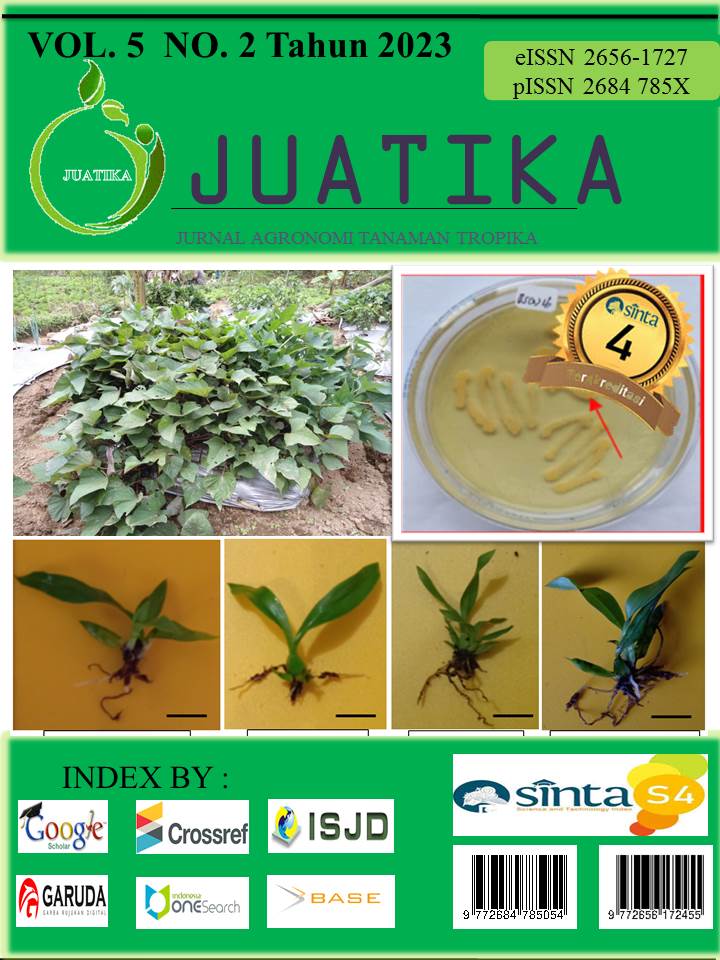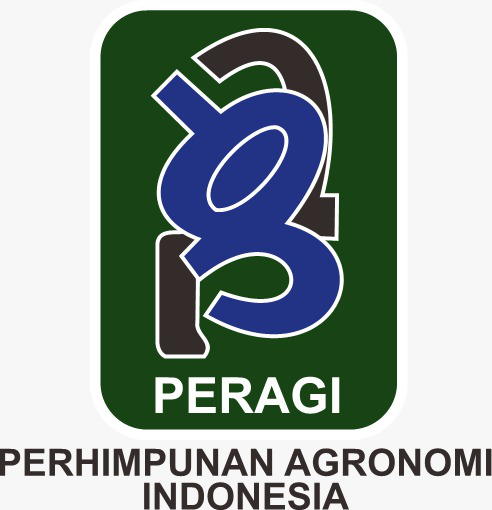Increasing The Growth Of Oil Palm Seeds by Administering Various Types and Dosages of Organic Fertilizer in The Main Nursery
Abstract
Oil palm seedlings can be grown using either organic or inorganic fertilization; however, organic fertilization is more environmentally beneficial. This study seeks to determine the impact of organic fertilizer type and dosage on the growth of oil palm seedlings in the main nursery. This investigation employed a two-factor factorial experimental method arranged in a completely randomized design (CRD). The form of organic fertilizer consists of three levels: banana stems, water hyacinth, and manure. The second factor is the organic fertilizer dosage, which consists of three levels: 100g, 250g, and 300g. Five repetitions yielded nine treatment combinations and one control treatment (plants without organic fertilizer ) from these treatments. Observations included plant height, leaf count, stem diameter, fresh crown weight, dried shoot weight, root length, fresh root weight, dry root weight, and root volume. The results demonstrated a significant interaction between the type and dosage of organic fertilizer on the parameters of plant height, root length, shoot fresh weight, root fresh weight, and root volume. The combination that yields the greatest results is 300 grams of manure. Applying organic fertilizer in varying quantities results in superior plant growth compared to the control (without organic fertilizer ).
Downloads
References
Adnan, I. S., Utoyo, B., & Kusumastuti, A. (2015). Pengaruh Pupuk NPK dan Pupuk Organik terhadap Pertumbuhan Bibit Kelapa Sawit (Elaeis guineensis Jacq.) di Main Nursery (The Effect of NPK Fertilizer and Organic Fertilizer on the Growth of Oil Palm [Elaeis guineensis Jacq.] Seedling in Main Nursery). Jurnal AIP, 3(2), 69–81.
Andri, R. ., & Wawan. (2017). Pengaruh Pemberian beberapa Dosis Pupuk Kompos (Greenbotani) terhadap Pertumbuhan Bibit Kelapa Sawit ( Elaeis quieneensis jacq) di Pembibitan Utama. JOM Faperta, 4(2), 1–14.
Astutik, D., Suryaningndari, D., & Raranda, U. (2019). Hubungan pupuk kalium dan kebutuhan air terhadap sifat fisiologis, sistem perakaran dan biomassa tanaman jagung (Zea mays). Jurnal Citra Widya Edukasi, 11(1), 67–76. http://journal.cwe.ac.id/index.php/jurnal_citrawidyaedukasi/article/view/188
Bahtiar, S. A., Muayyad, A., Ulfaningtias, L., Anggara, J., Priscilla, C., & Miswar, M. (2017). Pemanfaat Kompos Bonggol Pisang (Musa acuminata) Untuk Meningkatkan Pertumbuhan dan Kandungan Gula Tanaman Jagung Manis (Zea mays L. Saccharata). Agritrop : Jurnal Ilmu-Ilmu Pertanian (Journal of Agricultural Science), 14(1), 18–22. https://doi.org/10.32528/agr.v14i1.405
BPS. (2020). Statistik Kelapa sawit Indonesia 2020 (Direktorat). Badan Pusat Statistik. https://www.bps.go.id/
Darmawan, K. S., Udayana, I. G. B., Wirajaya, A. A. N. M., & Yuliartini, M. S. (2020). Pengaruh Konsentrasi Atonik dan Dosis Pupuk Kandang Sapi Terhadap Pertumbuhan Bibit Kelapa Sawit (Elaeis guineensis Jacq) Sistem Prenursery. Gema Agro, 25(1), 17–22.
Hafizah, N., & Mukarramah, R. (2017). Aplikasi Pupuk Kandang Kotoran Sapi Pada Pertumbuhan. Ziraa'Ah, 42, 1–7.
Hartatik, W., & Widowati, L. (2006). Pupuk Kandang. Balai Besar Penelitian dan Pengembangan Sumberdaya Lahan Pertanian.
Ismayanti, R. T., Fuskhah, E., Peternakan, F., & Diponegoro, U. (2020). Pengaruh Berbagai Dosis Pupuk Kompos Eceng Gondok dan Pupuk Hijau Azolla Microphylla Terhadap Pertumbuhan dan Produksi Tanaman Pakcoy (Brassica rapa L .). Buana Sains, 20(2), 217–226. https://jurnal.unitri.ac.id/index.php/buanasains/article/download/2255/1517
Kaswinarni, F., & Nugraha, A. A. S. (2020). Kadar Fosfor, Kalium dan Sifat Fisik Pupuk Kompos Sampah Organik Pasar dengan Penambahan Starter EM4, Kotoran Sapi dan Kotoran Ayam. Titian Ilmu: Jurnal Ilmiah Multi Sciences, 12(1), 1–6. https://doi.org/10.30599/jti.v12i1.534
Mayun, I. D. A. A. Y. U. (2007). Efek Mulsa Jerami Padi dan Pupuk Kandang Sapi terhadap Pertumbuhan dan Hasil Bawang Merah di Daerah Pesisir. 26(1), 33–40.
Parnata, S. ayub. (2010). Meningkatkan Hasil Panen dengan Pupuk Organik.
Prasetya, M. E. (2014). Pengaruh pupuk NPK mutiara dan pupuk kandang sapi terhadap pertumbuhan dan hasil tanaman cabai merah keriting varietas arimbi (Capsicum annuum L.). Agrifor, XIII(M), 191–198.
Rakhmawati, D. Y., Dangga, S. A., & Laela, N. (2019). Pemanfaatan Kotoran Sapi Menjadi Pupuk Organik. Jurnal Abdikarya: JurnalKarya Pengabdian Dosen Dan Mahasiswa, 03(1), 62–67.
Rastiyanto, E., Sutirman, & Pullaila, A. (2013). Pengaruh Pemberian Pupuk Organik Kotoran Kambing Terhadap Pertumbuhan dan Hasil Tanaman Kailan (Brassica oleraceae. L). Buletin IKATAN, 3(2), 36–40.
Ratriyanto, A., Widyawati, S. D., P.S. Suprayogi, W., Prastowo, S., & Widyas, N. (2019). Pembuatan Pupuk Organik dari Kotoran Ternak untuk Meningkatkan Produksi Pertanian. SEMAR (Jurnal Ilmu Pengetahuan, Teknologi, Dan Seni Bagi Masyarakat), 8(1), 9–13. https://doi.org/10.20961/semar.v8i1.40204
Rizki, M. (2018). Teknik Budidaya Tanaman Kelapa Sawit (Elaeis guinensiss Jacq.) Pada Tahapan Pre Nursery dan Main Nursery di PT. Socfindo Kebun Mata Pao. 1–17.
Roidah, I. S. (2013). Manfaat Penggunaan Pupuk Organik Untuk Kesuburan Tanah. 1(1).
Sakti, I. T., & Sugito, Y. (2018). Pengaruh Dosis Pupuk Kandang Sapi dan Jarak Tanam Terhadap Pertumbuhan dan Hasil Tanaman Bawang Merah ( Allium ascalonicum L . ) The Effect Of Cow Manure Dosage and Plant Spacing On Growth and Yield Of Shallot ( Allium ascalonicum L .). 3(2), 124–132.
Simanullang, A. Y., KartiniI, N. L., & Kesumadewi, A. A. I. (2019). Pengaruh Pupuk Organik dan Anorganik terhadap Pertumbuhan dan Hasil Tanaman Sawi Hijau (Brassica rapa. L). Agrotrop : Journal on Agriculture Science, 9(2), 166. https://doi.org/10.24843/ajoas.2019.v09.i02.p07
Copyright (c) 2023 Jogi Andre Rigel, Neny Andayani, Erick Firmansyah

This work is licensed under a Creative Commons Attribution 4.0 International License.
Authors who publish with Jurnal Agronomi Tanaman Tropika (JUATIKA) agree to the following terms:
Authors retain copyright and grant the Jurnal Agronomi Tanaman Tropika (JUATIKA) right of first publication with the work simultaneously licensed under a Creative Commons Attribution License (CC BY 4.0) that allows others to share (copy and redistribute the material in any medium or format) and adapt (remix, transform, and build upon the material for any purpose, even commercially) with an acknowledgment of the work's authorship and initial publication in Jurnal Agronomi Tanaman Tropika (JUATIKA).
Authors are able to enter into separate, additional contractual arrangements for the non-exclusive distribution of the journal's published version of the work (e.g., post it to an institutional repository or publish it in a book), with an acknowledgment of its initial publication in Jurnal Agronomi Tanaman Tropika (JUATIKA). Authors are permitted and encouraged to post their work online (e.g., in institutional repositories or on their website) prior to and during the submission process, as it can lead to productive exchanges, as well as earlier and greater citation of published work.







 More Information
More Information



